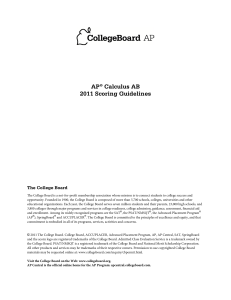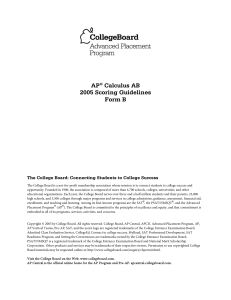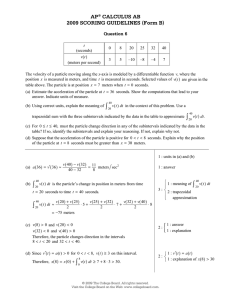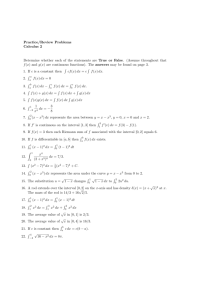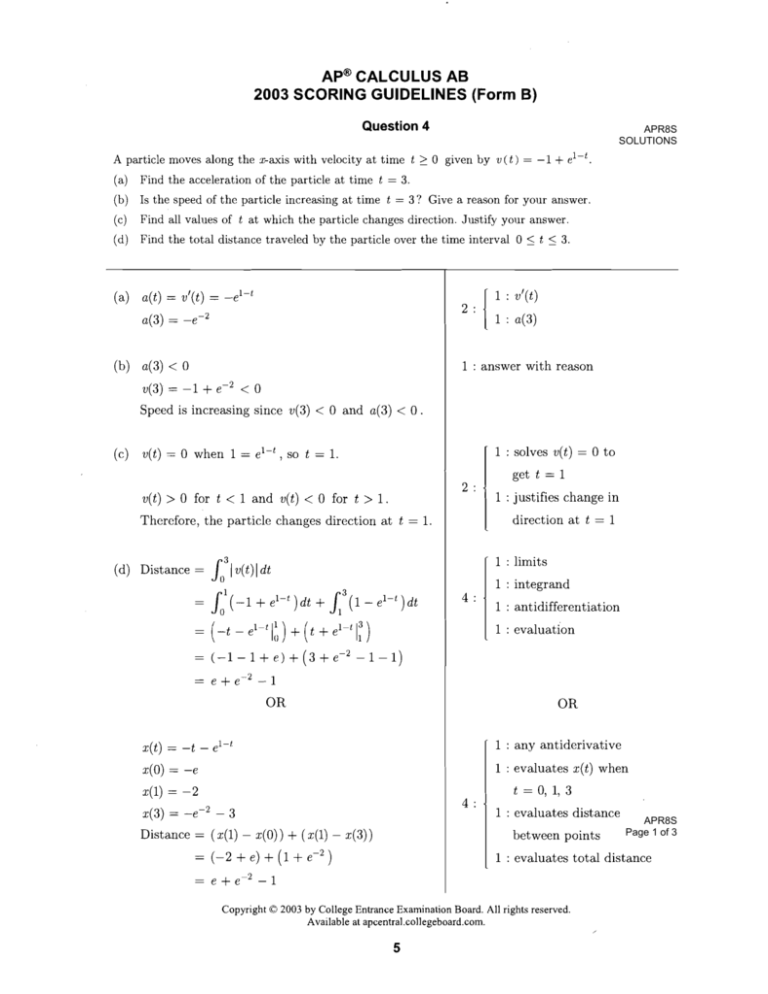
AP@CALCULUS AB
2003 SCORING GUIDELINES (Form B)
Question 4
A particle moves along the x-axis with velocity at time t
>0
APR8S
SOLUTIONS
given by v ( t ) = -1
+ elpt.
(a) Find the acceleration of the particle at time t = 3.
(b) Is the speed of thc particle increasing at time t = 3 ? Give a reason for your answer.
(c) Find all values of t at which the particle changes direction. Justify your answer.
(d) Find the total distance traveled by the particle over the time interval 0 5 t 5 3.
(a) a(t) = v l ( t ) = -el-'
a(3) = -eV2
1 : answer with reason
(b) 4 3 ) < 0
v(3) = -1
+ ep2
<0
Speed is increasing since v(3) < 0 and a(3) < 0 .
(c) v ( t ) = 0 when 1 = e l p t , so t = 1.
1 : solves v ( t ) = 0 to
get t = 1
v ( t ) > 0 for t < 1 and v ( t ) < 0 for t > 1 .
1 : justifies change in
Thercfore, the particle changes dircction at t = 1.
(d) Distance
=
iI3
1 v ( t )1 dt
direction at t = 1
1 : limits
1 : integrand
1 : antidifferentiation
1 : evaluation
x ( t ) = -t
1 : any antiderivative
- el-"
1 : evaluates x ( t ) when
x(0) = -e
t = 0, 1, 3
x(1) = -2
x(3) = -eP2
-
1 : evaluates distance
3
Distance = ( x ( 1 )- x ( 0 ) )
=
(-2 + e )
= e+ep2
+ (x(1)
-
x(3))
between points
+ (1 + e - 2 )
APR8S
Page 1 of 3
1 : evaluates total distance
-1
Copyright O 2003 by College Entrance Examination Board. All rights reserved.
Available at apcentral.collegeboard.com.
5
AP@CALCULUS AB
2003 SCORING GUIDELINES (Form B)
APR8S
SOLUTIONS
Question 5
Let f be a function defined on the closed interval [0,7]. The graph of
f, consisting of four line segments, is shown above. Let g be the
furiction given by g(i)
=
ST
2
f(t)dt.
(a) Find g ( 3 ) , g1(3), and g1'(3).
(b) Find the averagc rate of change of g on thc interval 0 5 x 5 3.
(c) For how many values c, where 0 < c < 3, is gl(c) equal to the
average rate found in part (b)? Explain your reasoning.
Graph off
(d) Find the %coordinate of each point of inflection of the graph of
g on the interval 0 < z < 7. Justify your answer.
(a) g(3)
=
J23 f ( t ) d t = -21( 4 + 2 ) = 3
g1(3) = f (3) = 2
0 -4
911(3) = f1(3) = -= -2
4 -2
2:
(
1 : g(3) - g(0)
=
Xf
(t)dt
1 : answer
[ 1 : answer of 2
(c) There are two values of c.
7
:
W e need - = gl(c) = f(c)
3
7
The graph of f intersects the line y = - a t two
3
places between 0 and 3.
2:
decreasing a t x = 2, and from decreasing t o
increasing a t x = 5.
1 : reason
Note: 112 if answer is 1 by MVT
(d) x = 2 and x = 5
because g1 = f changes from increasing t o
1
1
1 : x = 2 and x = 5 only
1 : justification
(ignore discussion a t x
=
4)
APR8S
Page 2 of 3
Copyright O 2003 by College Entrance Examination Board. All rights reserved.
Available at apcentral.collegeboard.com.
6
AP@CALCULUS AB
2003 SCORING GUIDELINES (Form B)
APR8S
SOLUTIONS
Question 6
Let f be the function satisfying f l ( z ) = z
m for all real numbers
z,where f ( 3 ) = 25
(a) Find f " ( 3 ) .
dy =
(b) Write an expression for y = f ( z ) by solving the differential equation dx
2J3
with the initial
condition f ( 3 ) = 25.
(a) fN(z)= m + z . -
x2
2 : f ll(x)
< -2 > product
or
chain rule error
1 : value at x = 3
1
(b) - d y = x d z :
a
1 : separates variables
1 : antiderivative of dy term
1 : antiderivative of dx term
1 : constant of integration
1 : uses initial condition f(3) = 25
1 : solves for y
Note: max 316 [l-1-1-0-0-01 if no
constant of integration
Note: 016 if no separation of variables
APR8S
Page 3 of 3
Copyright O 2003 by College Entrance Examination Board. All rights reserved.
Available at apcentral.collegeboard.com.





